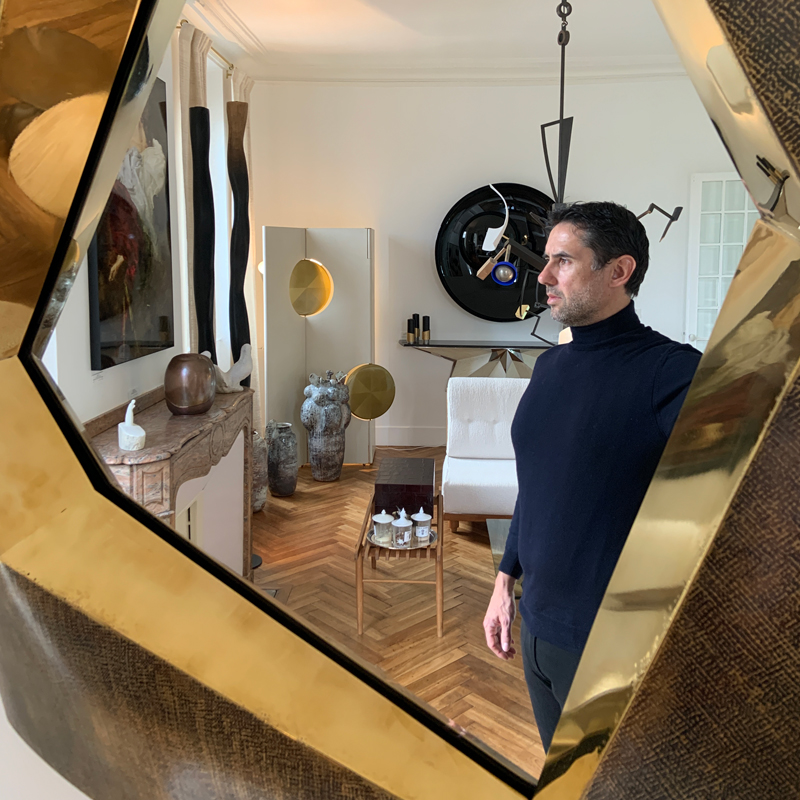Master of One: A Chat with Bespoke Furniture Maker Antoine Vignault
Septembre 2017 Robb Report USA
French designers never refer to their creations as “products.” That’s an American term with vapid implications. At the highest levels of craft, furniture is decadently uncommercial. Antoine Vignault doesn’t sweat the technique: More gallery than retail, more bodacious than bottom line, the designer’s exactingly handmade pieces slip past the collector’s typical catalog into a superb world where exuberance and precision win out—no matter how long it takes.
The founder of OAK in Bordeaux, Vignault began offering signed pieces in extremely limited numbers in 2014, though he had been accepting commissions for over two decades. Employing every sort of specialty—carpentry, inlay, leatherwork, art bronze, glassmaking, and ceramics—the collection is as original and hands-on as it gets. We asked the designer, whose studio is “located between the ocean and the millenarian vineyards,” about history, influence, and creating furniture with soul.
Tell us about your design background.
Since I remember, I always thought about creating things. First of all, I’ve studied mechanical engineering, where I’ve learned how to create a functional object from inside to outside. Then I was obsessed by the links between the functionality and the shape with all the possibilities given by an artistic perspective. That’s why I’ve followed some additional graduate studies about industrial design with a specialization in furniture design.
Why did you choose to create furniture instead of focusing on another type of design?
Since I was young, I have been fascinated by archeology and history of former civilizations. The incredible timeless beauty of the artefacts exposed in the most famous museums in the world helped me to choose my way . . . most of these pieces were parts of the decorative arts. I always kept in mind this idea that useful objects should be considered like art pieces.
How would you describe the style of your creations?
I guess there is also a kind of timeless beauty in my works—a sharp combination of historical references, sacred symbols, and precious finishes. The kind of style which can match with the most refined pieces from every age and probably out of temporary trends.
What inspires your work?
I love the timeless themes like the cosmos, the sacred geometry but also the former myths and legends or philosophy—all the sciences where a modern alchemist could find references for his quest.
How has the new attention on handcraftsmanship changed what you do and the types of commissions you receive?
There had always been an interest for handmade works by cultivated people who are able to recognize the potential value of an artwork without reading a signature or a price. Today, the access to the knowledge is more democratic and gives more visibility to the talent. Nevertheless, the quality is still too confidential.
Why did you want to produce a collection of limited-edition works rather than a produced range?
More than editions, each piece is handmade on request and will receive few modifications and details, which give to them a unique aspect. That’s why OAK is also the acronym of one-of-a-kind. This approach is necessary to keep the sacred dimension you’ll never find in industrial design. When I’’d launched my studio, I already had several sketchbooks full of ideas I’d love to explore. So when a “series” is sold out, I prefer to build a new concept than to develop a range with the same DNA.
What types of techniques are used in your furniture?
I’m fascinated by the patina which increases the beauty of the natural materials with time. I’m not mad about resin and synthetic materials which have a planned obsolescence with no options to restore them. That’s why I try to explore new ways to enrich woods, metals, skins, stones, or glass with innovative finishes.
How do you see the modern way to collect—whether it’s art or furniture or vintage cars?
I think it exists as many ways to collect as collectors. That’s not a rational behavior, so it should be a mistake to format it. From my own point of view, I prefer to focus on pieces which catch your attention not only at the first sight but also after have seeing them under different angles and in different lighting without taking care of the text written on the side. If you’re still fascinated by a piece after this inspection, that should be a good choice and it should match with the next one even if it’s not from the same “category.”



